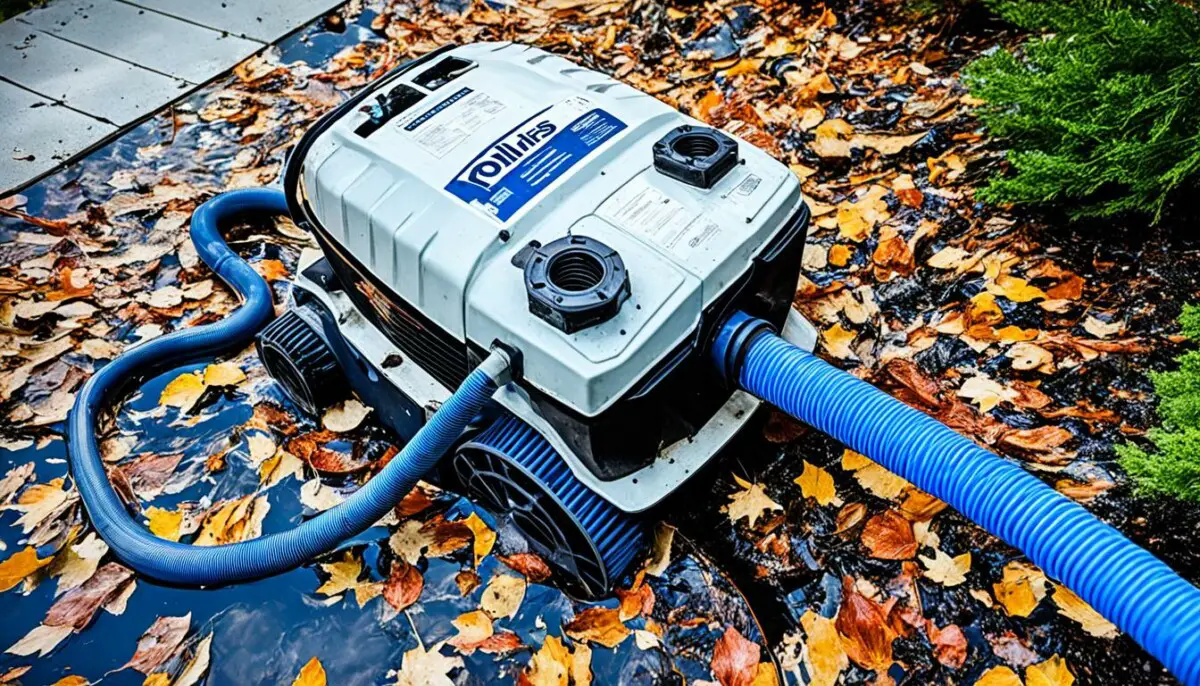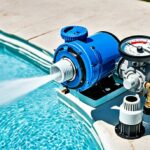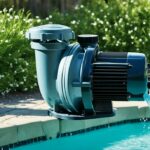Last Updated on 3 months by Francis
Is your Polaris pool cleaner not moving? Don’t worry, we’ve got you covered. Polaris is a trusted brand known for its efficient pool cleaners, but like any mechanical device, they can encounter issues. In this article, we will provide you with some quick troubleshooting tips to get your Polaris cleaner back up and running in no time.
Troubleshooting a Polaris pool cleaner that’s not moving can save you time and effort in keeping your pool clean and enjoyable. Whether your cleaner is a Polaris 360 or Polaris 280, we’ll cover a range of common problems that could be causing the issue, such as a clogged quick disconnect or broken belts. By identifying the specific problem, you can take the necessary steps to resolve it and restore your cleaner’s movement.
Contents
Key Takeaways:
- Troubleshooting your Polaris pool cleaner not moving can help identify common issues.
- Issues may stem from a broken booster pump, clogged quick disconnect, or leaky float hose.
- Broken belts and disconnected internal tubing can also cause the cleaner to stop moving.
- Pay attention to the length of the hose, connectors, and RPM settings to ensure optimal performance.
- Maintain your cleaner regularly and address any issues promptly for longevity and effectiveness.
Common Polaris Pool Cleaner Problems
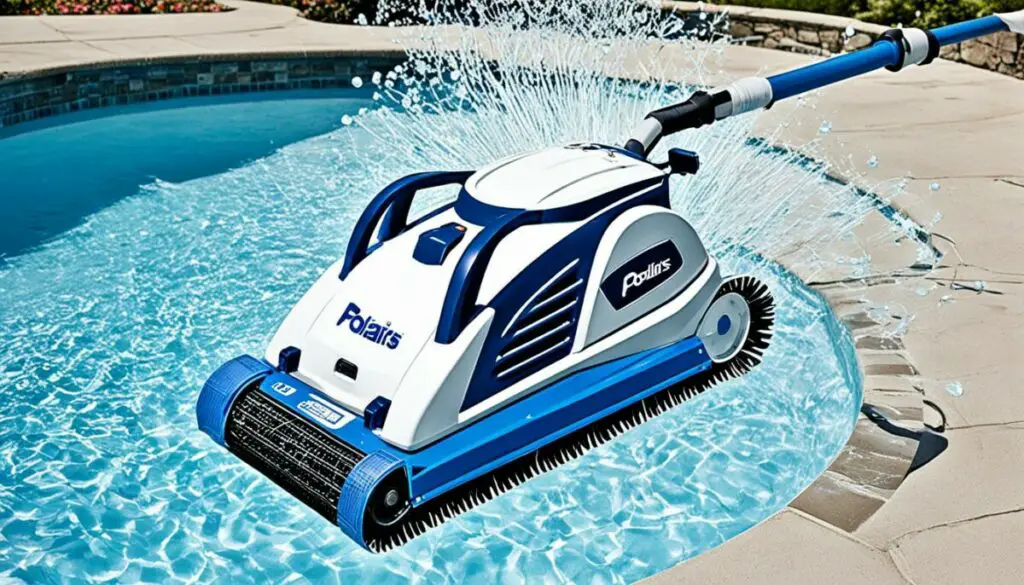
If your Polaris pool cleaner is not moving, it can be a frustrating issue to deal with. However, there are several common problems that could be causing this problem, and by identifying the specific issue, you can quickly troubleshoot and resolve it. Here are some of the most common problems that can cause a Polaris pool cleaner to stop moving:
- Booster Pump Issues: The booster pump provides the necessary pressure for the Polaris cleaner to move. If the booster pump is not working properly, the cleaner may not move or move sluggishly. Check the pump and ensure it is functioning correctly.
- Clogged or Broken Quick Disconnect: The quick disconnect connects the Polaris cleaner’s hose to the return jet. If it becomes clogged with debris or breaks, it can impede the movement of the cleaner. Inspect the quick disconnect and clean or replace it if necessary.
- Leaky Float Hose: The float hose carries water from the cleaner to the return jet. If there is a leak in the hose, it can disrupt the water flow and cause the cleaner to stop moving. Inspect the float hose for leaks and replace it if needed.
- Leaky Back-Up Valve: The back-up valve is responsible for the intermittent movement of the Polaris cleaner. If the valve is leaking or constantly spraying water, it may need to be replaced to restore proper movement.
- Broken Belts: The wheels of the Polaris cleaner rely on drive belts to turn. If any of these belts are broken, it can cause the cleaner to stop moving. Lift the cleaner out of the pool and check for any broken belts. Replace them as necessary to restore movement.
- Disconnected Internal Tubing: The internal tubing directs pressure throughout the Polaris cleaner. If any of the tubing becomes disconnected, it can disrupt the water flow and prevent movement. Inspect the internal tubing and ensure all connections are secure. Reattach any disconnected tubing and use hose clamps to secure them in place.
Troubleshooting these common problems can help you get your Polaris pool cleaner back to working order. By addressing the specific issue causing the lack of movement, you can ensure that your pool stays clean and ready for enjoyment.
Broken Booster Pump

If your Polaris pool cleaner seems to lack strong pressure from the return line, the issue may lie with a broken booster pump. Before jumping to conclusions, it is essential to check the pump and filter for proper functionality. If these components are working correctly, it is likely that the booster pump needs attention.
Repairing a malfunctioning booster pump can be both time-consuming and expensive. In some cases, it may actually be more cost-effective to replace the pump entirely. Consider seeking professional assistance or consulting the Polaris pool cleaner troubleshooting guide for further guidance.
Checking the Pump and Filter
- Inspect the pump and filter for any visible signs of damage or obstruction.
- Ensure that the pump is receiving sufficient power and that it is properly connected.
- Check the filter for any excessive debris or clogs, as these can impede the pump’s performance.
Diagnosing the Booster Pump
If the pump and filter appear to be in good working order, yet the Polaris cleaner still fails to move, it is likely that the booster pump is at fault. Indications of a broken booster pump include:
- Lack of water flow or reduced water pressure through the return line.
- Unusual noises or vibrations coming from the pump.
- Visible leaks or cracks in the pump housing.
To confirm whether the booster pump is the source of the problem, it is recommended to consult a professional technician or refer to the Polaris pool cleaner troubleshooting guide for specific diagnostic steps.
In some cases, the booster pump may simply require maintenance or minor repairs. However, if the damage is severe or the cost of repairs outweighs the investment in a new pump, replacing the booster pump may be the most practical solution.
| Signs of a Broken Booster Pump | Recommended Actions |
|---|---|
| Lack of water flow or reduced pressure | Check pump power and connections Inspect the pump for physical damage Consult a professional technician for further assessment |
| Unusual noises or vibrations | Examine the pump for loose or damaged parts Consider professional repairs or replacement if necessary |
| Visible leaks or cracks | Assess the extent of the damage Compare the cost of repairs to a new booster pump Make an informed decision based on cost-effectiveness |
Remember, maintaining your Polaris pool cleaner regularly and promptly addressing issues can help ensure efficient operation and extend its lifespan.
Clogged or Broken Quick Disconnect
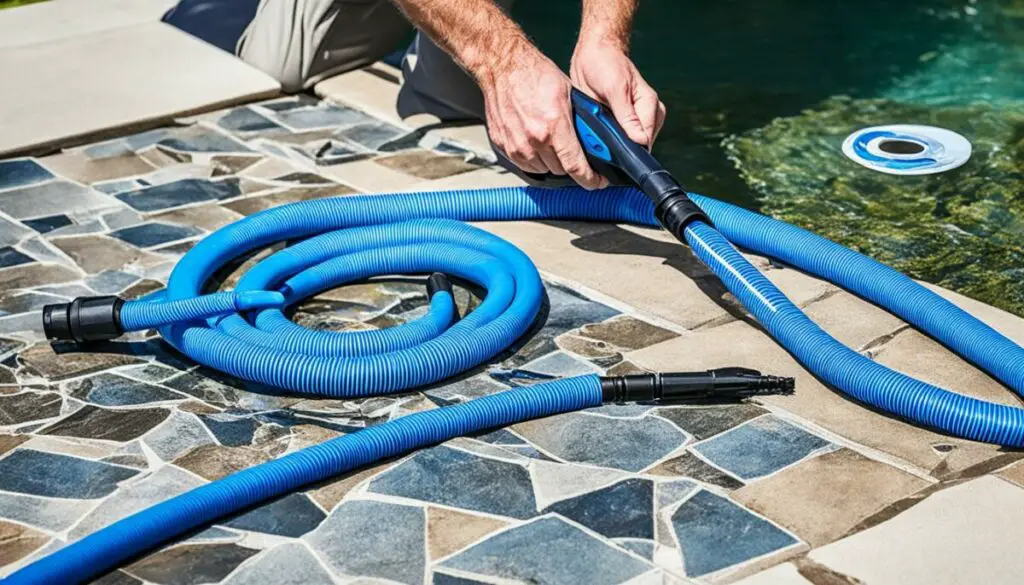
One of the common causes of a Polaris pool cleaner not moving is a clogged or broken quick disconnect. The quick disconnect is the piece that connects the cleaner’s hose to the return jet.
Inside the quick disconnect, there is a screen that can become clogged with debris over time, impeding the flow of water and causing the cleaner to stop moving. It is important to regularly check and clean this screen to ensure proper water flow and movement of the cleaner.
Additionally, inspect the quick disconnect itself for any signs of damage. If you notice any cracks or breaks, it is likely that the quick disconnect is broken and needs to be replaced.
Leaky Float Hose
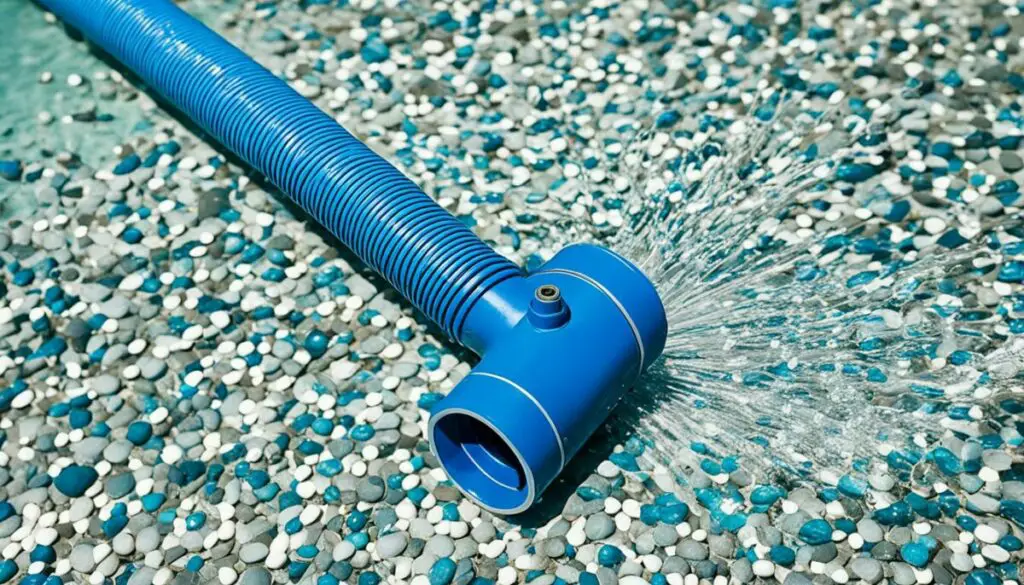
The float hose of a Polaris pool cleaner plays a crucial role in maintaining proper pressure and movement of the cleaner. It carries water from the cleaner to the return jet, ensuring effective cleaning of your pool. However, if the float hose develops a leak, it can result in reduced pressure and stop the cleaner from moving forward.
To troubleshoot this issue, carefully inspect the float hose for any signs of leakage. Look for visible cracks, holes, or loose connections. Even a small leak can significantly impact the performance of the Polaris cleaner.
If you identify a leak in the float hose, it’s important to address it promptly to restore optimal movement to your cleaner. Depending on the severity of the leak, you may be able to repair it using waterproof sealant or tape. However, if the leak is substantial or multiple leaks are present, it’s recommended to replace the float hose.
When replacing the float hose, ensure you choose a compatible hose that matches the specifications of your Polaris cleaner. Follow the manufacturer’s instructions for proper installation to maintain the integrity of the cleaner and avoid further issues.
Leaky Back-Up Valve
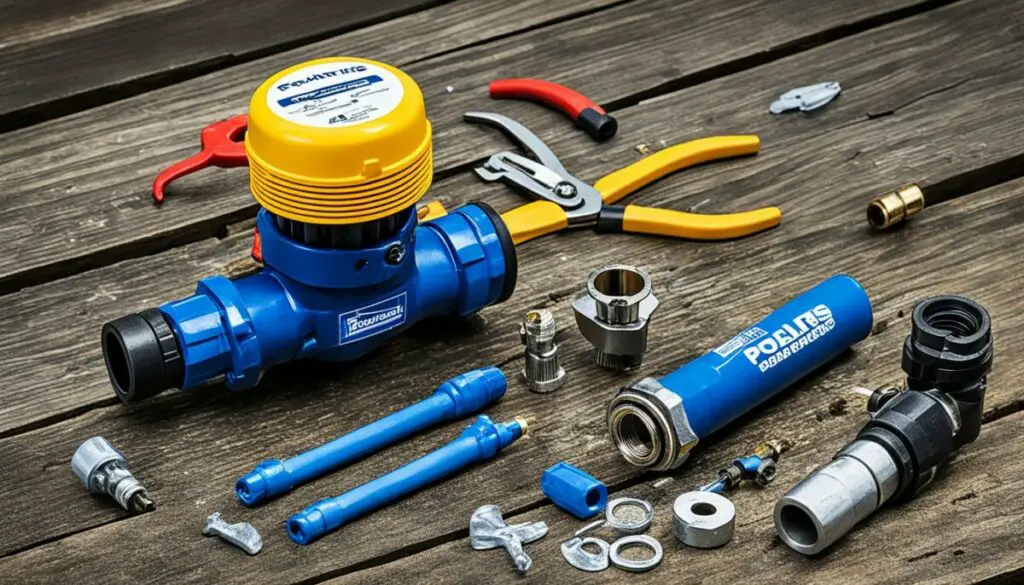
In some cases, a malfunctioning back-up valve can be the cause of a Polaris pool cleaner not moving. The back-up valve plays a crucial role in propelling the cleaner by releasing high-pressure bursts of water. If the valve is leaky or constantly spraying water, it needs to be replaced to restore proper functionality.
A leaky back-up valve can prevent the cleaner from moving forward as intended, resulting in limited or no movement at all. This issue can be resolved by replacing the faulty back-up valve with a new one. By doing so, you can ensure that the cleaner operates effectively and moves around the pool as it should.
When troubleshooting your Polaris pool cleaner, it’s important to check the back-up valve and address any leaks promptly. By resolving this issue, you can significantly improve the performance and movement of your pool cleaner.
By following these troubleshooting tips, you can identify and address the common issues that can cause a Polaris pool cleaner to stop moving. Whether it’s a broken booster pump, clogged or broken quick disconnect, leaky float hose, or malfunctioning back-up valve, taking the necessary steps to resolve these problems will help restore the proper movement and functionality of your Polaris cleaner.
Broken Belts

The wheels of a Polaris pool cleaner rely on drive belts to turn. These belts play a crucial role in the movement of the cleaner. However, if one or more belts break, it can cause the cleaner to stop moving altogether.
To check if broken belts are the cause of your Polaris cleaner not moving, lift the cleaner from the bottom of the pool and inspect the wheels. If they don’t turn freely or have difficulty rotating, broken belts might be the issue.
To resolve this problem, you will need to open up the cleaner and locate the broken belts. Remove the old belts and replace them with new ones that are compatible with your specific Polaris model. Make sure to follow the manufacturer’s instructions for proper belt installation.
By replacing the broken belts, you can restore the movement to your Polaris cleaner and ensure that it effectively cleans your pool once again.
Disconnected Internal Tubing
The internal tubing of a Polaris pool cleaner plays a crucial role in directing pressure throughout the cleaning unit. However, if the tubing becomes disconnected, it can result in reduced internal pressure, causing the cleaner to stop moving.
To troubleshoot this issue, you’ll need to open up the cleaner and examine the internal tubing. Check that all the tubing is properly connected and securely attached. If you find any disconnected tubing, reattach it and use hose clamps to ensure a secure fit.
Regularly inspecting and maintaining the internal tubing will help prevent disconnections and ensure the proper functioning of your Polaris pool cleaner.
Tangles and Hose Length
Sometimes, a Polaris pool cleaner may not be moving because it has become entangled in its own hose or power cable. This can hinder its ability to function properly and impact its overall performance. To address this issue, it is important to consider the length of the hose.
Shortening the hose length can help prevent tangles and ensure smoother movement of the cleaner. When the hose is too long, it becomes more prone to tangling, especially when the cleaner changes direction. By measuring the appropriate hose length for your pool and cutting the hose accordingly, you can help minimize the risk of excessive tangling.
It is important to note that while optimizing hose length can help reduce tangles, it is crucial to ensure that it is still long enough for the cleaner to reach all areas of your pool effectively. Finding the right balance between length and maneuverability is key.
By paying attention to the hose length and avoiding excessive tangling, you can help maximize the efficiency of your Polaris pool cleaner and maintain its optimal performance.
Check the Connectors and RPM
When troubleshooting a Polaris pool cleaner that is not moving, it’s important to examine the connectors and check the RPM (revolutions per minute) settings. These two factors can significantly impact the cleaner’s movement and overall performance.
The connectors that join the hose segments of a Polaris pool cleaner play a crucial role in allowing the hose to move freely. Over time, these connectors can become loose or worn, causing restrictions in movement. Inspect the connectors and ensure they are securely attached and not damaged. If you notice any issues, replace the connectors as necessary to restore proper movement to the cleaner.
Additionally, it’s essential to verify that the cleaner’s RPM is set to the appropriate level. The RPM controls the speed and efficiency of the cleaner. If the RPM is too low, the cleaner may not be able to reach maximum movement or effectively clean the pool. Check the manufacturer’s guidelines or refer to the user manual to determine the recommended RPM for your specific Polaris pool cleaner model. Adjust the RPM settings accordingly to optimize the cleaner’s performance.
By thoroughly examining the connectors and adjusting the RPM settings, you can address potential issues that may be preventing your Polaris pool cleaner from moving. These troubleshooting steps will help ensure the cleaner operates smoothly and effectively, keeping your pool clean and inviting.
Conclusion
Troubleshooting your Polaris pool cleaner not moving can be a straightforward process that can save you time and ensure a clean and well-maintained pool. By following the quick tips provided in this article, you can easily identify and resolve common issues that may be causing your Polaris pool cleaner to stop moving. Whether it’s a broken booster pump, a clogged quick disconnect, or a leaky float hose, addressing these problems promptly will help restore your cleaner’s functionality.
Regular maintenance and prompt troubleshooting are key to keeping your Polaris pool cleaner in optimal condition. By addressing any issues as they arise and ensuring proper functioning of connectors, belts, and internal tubing, you can prevent your cleaner from experiencing further problems in the future. Remember to also verify the appropriate hose length and RPM settings for optimal performance.
Don’t let a non-moving Polaris pool cleaner dampen your enjoyment of a sparkling pool. With the troubleshooting tips provided in this article, you can easily diagnose and resolve common issues, enabling you to get your Polaris cleaner back to work and enjoy a clean and inviting pool all season long.
FAQ
What can cause a Polaris pool cleaner to stop moving?
Several common issues can cause a Polaris pool cleaner to stop moving, including problems with the booster pump, clogged or broken quick disconnect, leaky float hose, leaky back-up valve, broken belts, and disconnected internal tubing.
How can I determine if the booster pump is causing the issue?
First, check the pump and filter to ensure they are working properly. If they are, the issue is likely with the booster pump. Repairing the booster pump can be time-consuming and expensive, so it may be more cost-effective to replace it.
What should I do if the quick disconnect is clogged or broken?
Check the quick disconnect for any signs of damage and clean it if necessary. If the quick disconnect is broken, it will need to be replaced.
How can I fix a leaky float hose?
Inspect the float hose for any leaks and replace it if necessary to restore proper pressure and movement to the cleaner.
What should I do if the back-up valve is leaky?
If the back-up valve is leaky or constantly spraying water, it needs to be replaced to restore proper functionality to the cleaner.
How can I determine if the belts are broken?
Lift the cleaner from the bottom of the pool and check whether all the wheels turn. If they don’t, open up the cleaner to locate and replace any broken belts to restore movement.
What should I do if the internal tubing is disconnected?
Open up the cleaner and check that all the internal tubing is properly connected. If necessary, reattach them and use hose clamps to secure them in place.
How can I prevent tangles and ensure smoother movement?
Shortening the hose length can help prevent tangles. Measure the appropriate hose length for your pool and cut the hose accordingly to avoid excessive tangling.
Should I check the connectors and RPM?
Yes, check the connectors to ensure they are functioning properly and apply lubricant if needed. Additionally, make sure the cleaner’s RPM (revolutions per minute) is set to the appropriate level for optimal performance.
How can troubleshooting help resolve my Polaris pool cleaner not moving?
Troubleshooting can help you identify and resolve common issues that may be causing the problem. By following the quick tips provided, you can get your Polaris cleaner back to working order and enjoy a clean and sparkling pool.

